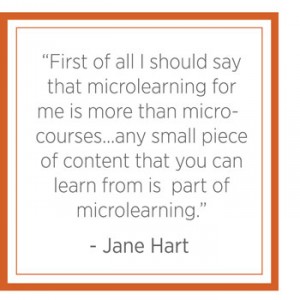Connecting Social Media and Microlearning: An Interview with Jane Hart
As we all continue to look for information, entertainment and answers in an instant, it’s no surprise that microlearning is on the rise. Microlearning provides learners with the information they need, when they need it, usually in short bursts. Social media channels such as YouTube and Twitter have added a new element to the learning process because they enable real-time sharing of information.
We spoke with Jane Hart, founder of the Centre for Learning & Performance Technologies and a leading figure on workplace learning. She expressed her thoughts on how microlearning fits in with today’s modern learners, its connection to social media and the opposition faced by traditionalists.
[Tweet This]AllenComm: Simply put, what is the connection between social media and microlearning?Jane Hart: It is the fact that people are: a) having shorter experiences on social media, i.e. accessing small pieces of content (in a range of formats from short videos they’ve found on YouTube to tweets, etc); b) they are spending shorter amounts of time on it – measured in seconds or minutes; and c) they are now used to receiving a drip-feed of micro content, which over time builds up – almost unconsciously – into a large body of knowledge.
AC: In your experience, how has social media changed corporate learning?
JH: Well, largely it hasn’t, since most people think corporate learning is about large corporate training courses, which are measured in hours or days, and are based on the authoritative voice. However, some have realised that they do need to make content shorter, as well as support social interactions between individuals in the workplace – in a similar way on their enterprise social network.
AC: Some experts don’t see social media as a good tool for microlearning. Do you think these objections are centered solely on workplace learning, or also in academic work?
JH: Unfortunately these so-called experts often don’t think social media is a tool for any type of learning! However, we have seen from my Top 100 Tools for Learning list that the dominant tools on the list are online social tools. But it is clear these are being used primarily for personal and professional learning rather than training/elearning. For corporate (e-)training, instructional designers tend to turn to their existing elearning authoring tools to create a “training package.
AC: With younger generations of learners being heavily connected and invested in social platforms and technology, does this alone make them good candidates for microlearning courses? Or is there more to the picture?
JH: First of all I should say that microlearning for me is more than micro-courses – that is just part of the picture. Any small piece of content that you can learn from is part of microlearning. But I do think anyone who has been immersed in the Social Web and is now in tune with this way of learning, means that they now find traditional training/courses very unappealing. So in terms of a micro-course – offering a drip-feed of short pieces of content on an ongoing basis with opportunities for social interaction – I think is going to be a more effective way for the future. I call it a Learning Flow.
AC: What are some of the common misconceptions that deter decision-makers from choosing to implement a microlearning course?
Do you use social tools in your courses?
JH: Often when they have never experienced anything like it themselves, they are wary of it – and ask, “Will it work? Will people learn?” But in my experience, anything that is closer to an individual’s normal way of working/learning will be more willingly accepted, particularly since it means learning is no longer seen as an onerous experience. But the best way to find out is to try it!
Conclusion
Microlearning and social media will probably not be substituted for extensive corporate training courses, but they clearly have a place in the learning environment.
There is an obvious need from a personal perspective and microlearning/social integrations are catching on, to a degree, in the modern workplace. It seems that the greatest challenge these avenues currently face is a willingness to simply try them.
What do you think of Jane’s take on how social fits with microlearning? Do you use social tools in your courses?






